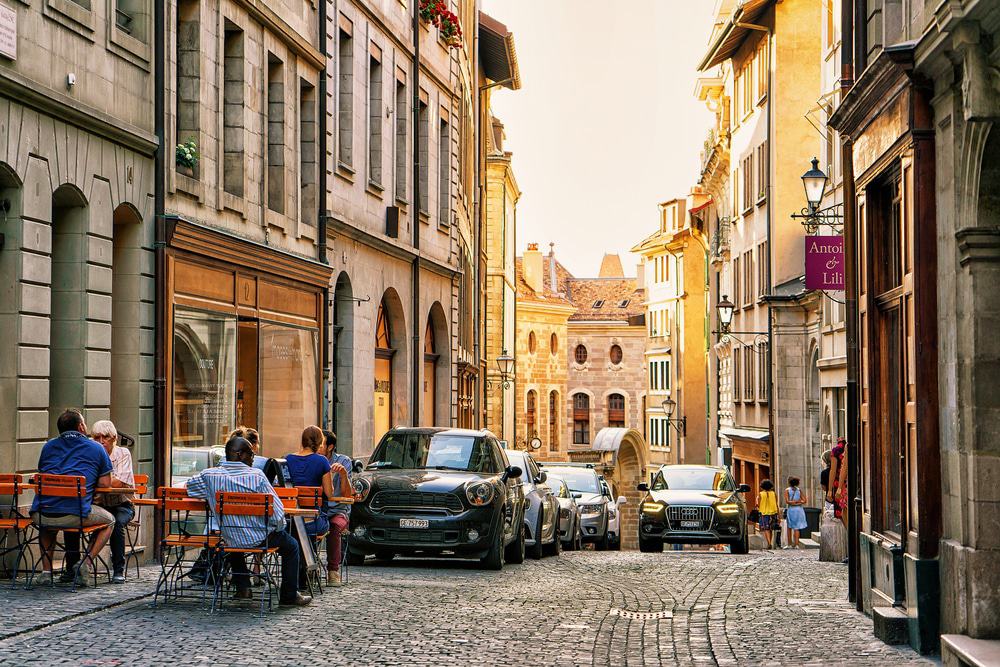You’ve probably heard all the stereotypes about Geneva. But it’s only when you come that they can be challenged. Yes there’s wealth, fondue, chocolate and watchmaking. But Geneva is also charged with diversity and creativity, in neighbourhoods like Les Grottes or the Italian-flavoured Carouge.
TIP – Get the Geneva Pass for free access to museums, several tours, cruises and transportation
Lake Geneva and its iconic plume of water will draw your eye on promenades and lush waterside parks, while Mont Salève is a slice of the Alps in the background. Geneva is still a beacon of diplomacy, where organisations like the United Nations and the Red Cross convene. Experts of a different kind come together to answer the great scientific questions of our time at CERN. And hundreds of years ago the course of European history was changed in Geneva during the Protestant Reformation.
Let’s explore the best things to do in Geneva:
1. Lake Geneva

Source: Shutterstock
Lake Geneva
The largest lake in Central Europe brings the drama and awe-inspiring natural splendour of the Alps to the centre of the city.
Nobody could blame you for wanting to get out and experience it, and the easiest way to do that is to catch a boat from the quay at Genève-Mt-Blanc.
These shoot off to a host of places on the shores of the lake: You could keep it local on a “mouette”, shuttling to the other side of the city, or go long distance and cruise to Lausanne in three hours.
The lake’s beauty has affected the design of the city itself, as a promenade was built around the shore in the mid-19th century.
Next to the water are tree-lined promenades with palatial townhouses or serene parks like Eaux-Vives, Jardin Anglais, Perle du Lac or Mon Repos.
2. Jet d’Eau

Source: Shutterstock
Jet D’Eau
At the city centre, where the Rhône continues on its course into France is La Rade (The Roadstead). Here, at the end of a long jetty, is a much-imitated monument known the world over.
The Jet d’Eau is five hundred litres of water per second propelled to a height of 140 metres.
If you do want to get a closer look, take care as the plume is susceptible to the wind and you may get wet.
The jet has been at its present spot since 1951, and originally had an important practical use: It started in 1886 as a safety valve for the hydraulic power plant, and became a permanent monument as the city loved the way it looked.
3. St Pierre Cathedral

Source: Shutterstock
St Pierre Cathedral
Geneva Cathedral is one of those religious buildings that needs as much time as you can afford.
Beyond the recent Neoclassical facade things are much older, with architecture that dates to the 12th century.
From 1541 it was the home church of John Calvin, and his personal chair looks like he just got up from it.
The cathedral was constructed on top of much older buildings , among which is a basilica from the 4th century.
This and a variety of ancient vestiges can be explored underground at the archaeological site.
You can also go up the cathedral’s towers to view the Alps, Jura and Geneva against its lake: The south’s viewing platform is open-air, while the north is in a closed room and might be more suitable in winter.
4. Vielle Ville

Source: Roman Babakin / Shutterstock.com
Vielle Ville
Allow a couple of hours to satisfy your curiosity in the largest historic centre in Switzerland.
The Vielle Ville twists around the hill capped by the cathedral and was once enveloped by defensive walls.
Getting around on these steep cobblestone streets and stairways is tiring but worthwhile: The old centre is densely packed with intriguing little corners, fountains, terraces with lookouts, as well as places of real historic value.
The 18th-century polymath Jean-Jacques Rousseau was born here, while Bourg-de-Four has a row of evocative historic houses on a friendly square where cattle markets traded in medieval times.

0 تعليقات